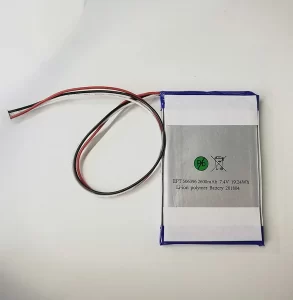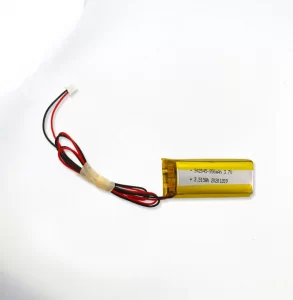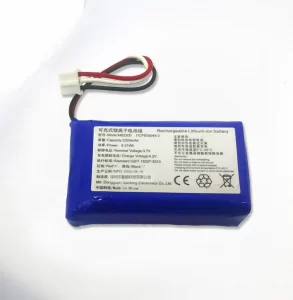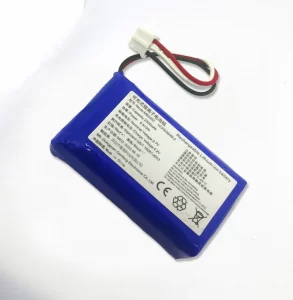Introduction:
Batteries have become an essential part of our everyday life. There are many types of batteries on the market. Lithium polymer battery, also called LiPo battery, is popular with many people. As a new type of battery, lithium polymer batteries are used in a wide range of electronic areas. Next, we will explore the lithium polymer battery in more detail.
What is lithium polymer battery?

Firstly, structurally speaking, the full name of a lithium polymer battery is a lithium ion polymer battery. As a result, a lithium-ion battery can also be a lithium polymer battery. The electrolyte utilized inside the two is the primary distinction between them. Unlike lithium-ion batteries, which utilize a liquid electrolyte, lithium ion polymer batteries employ an electrolyte made of a solid polymer that can either be solid or semi-solid (gel). The high energy density, increased miniaturization, ultra-thinness, and lightness, as well as the high safety and low cost of polymer lithium battery, are further advantages. Lithium polymer batteries are ultra-thin and may be produced in any shape and size to meet the requirements of a variety of devices.
The history of lithium polymer battery

Alessandro Volta created the first practical method of producing electricity: batteries. Batteries were the primary source of electricity prior to the advent of generators. The history of batteries played a crucial role in the creation of lithium polymer battery cells. In the 1980s, with the further development of lithium ion and lithium metal batteries, lithium polymer battery cells were created. The introduction of Sony’s first lithium-ion commercial battery in 1991 was a significant turning point. Following that, a “LiPo” battery in a pouch form was developed.
Advantages and disadvantages of lithium polymer battery
The polymer lithium ion battery is based on the lithium-ion battery. As such, in addition to lithium-ion battery characteristics, it also has additional features. We will look in depth at the advantages and disadvantages of lithium ion polymer batteries here.
Advantages of LiPo batteries
1. Thin thickness
The liquid lithium battery is first customized with a shell and then stuffed with the positive and negative electrode material. Therefore, when it is smaller than 3.6mm thick, there is a technological block. However, the li-ion polymer battery does not have this issue. According to the direction of thinning application development, the thickness can be less than 1mm.
2. Big capacity
The thickness of lithium polymer batteries can be less than 1mm. Despite their thinness, they have a large capacity. Compared to other batteries of the same size and dimensions, lithium ion polymer batteries have 10-15% more capacity and are more capable. The high capacity lithium polymer battery is also popular with many manufacturers as a result.
3. Lightweight
Lithium polymer batteries do not use a metal case as protective outer packaging. This reduces the weight considerably. Lightweight is then one of the advantages of lithium polymer batteries.
4. Customizable shape
Lithium polymer batteries are ultra-thin and may be produced in any shape and size to meet the requirements of a variety of devices. Its shape can be customized indefinitely, and producers make the most of this fact.
5. Good discharge characteristic
The lithium ion polymer batteries employ an electrolyte made of a solid polymer that can either be solid or semi-solid (gel). Compared to liquid electrolytes, it offers more steady discharge properties and a higher discharge platform.
6. Low internal resistance
Compared to liquid batteries, polymer batteries have a lower internal resistance. This small internal resistance significantly reduces the power consumption of the battery and effectively extends the standby time of the application. There is no doubt that this feature of lithium polymer batteries makes them very popular in the electronics market.
7. High safety
The high safety is also a feature of lithium polymer batteries that cannot be ignored. Lithium polymer batteries are exceptionally protected to utilize. The outer packaging is a flexible aluminum-plastic package that protects them from any explosion or hazardous situation. Unlike the metal casing of liquid lithium batteries, lithium polymer batteries use flexible packaging technology. Inside quality dangers can be promptly uncovered by the deformity of the external bundling, which won’t detonate yet just extend in that frame of mind of a wellbeing peril. This provides a good level of security. It is also worth noting that lithium polymer batteries have no battery leakage problems, as they use a solid gel inside the battery and do not contain liquid electrolytes. These provide a good level of safety.
8. Environmentally friendly
It is worth focusing on that lithium polymer batteries don’t contain destructive metals. One might say that the polymer lithium ion battery is contamination-free, green, and harmless to the ecosystem battery.
Disadvantages of LiPo batteries
In addition to the advantages mentioned above, lithium polymer batteries also have several disadvantages. Compared to Li-ion batteries, they are more expensive. In addition, it does not have a long cycle life of around 500 or more.
How to properly charge a lithium polymer battery?


After learning the basics of lithium polymer batteries, all you need to know is how to charge your batteries. Only by using the correct method of charging will you be able to maintain your battery better and extend its life.
Lithium charging is currently mainly a voltage and current limiting method. Initially, constant current (CC) charging is the most acceptable for the battery. Polarization becomes stronger, the temperature rises, and the voltage rises as the charging process continues. The voltage hits the maximum charge limiting voltage and transitions to the constant voltage (CV) charging stage when the charge is between 70 and 80 percent. The current intensity diminishes, and the temperature rise stops rising during the constant voltage phase.
Both overcharging and overcharging can be fatal to the battery. The distinction is that overcharging emits a lot of gas, is more likely to spontaneously ignite and explode, and has a threatening aspect. Over-discharging, on the other hand, is slow to change in appearance but fails very quickly. Both should be completely kept away from ordinary use.
Therefore, choosing a good quality special lithium polymer battery charger is essential. To charge correctly, you must know the specifications of your lithium polymer battery. Remember not to exceed the maximum voltage and current. The aim of everything is to extend the battery’s life as much as possible and to increase the number of cycles the battery can use.
How to store a lithium polymer battery?
When not in use, lithium polymer batteries should be kept in a cool, dry location at around 50% of their full capacity. A LiPo battery’s lifetime will be significantly shortened if it is stored close to either its minimum or maximum voltage. The storage program on the majority of contemporary battery balance chargers will charge or discharge your LiPo battery to the proper storage voltage.
Conclusion:
This is the basic content of a lithium polymer battery. Are you starting to get interested in it? Or, do you know most of what it is? You should know that the lithium polymer battery is very popular. It has the potential to overtake the use of NiMH batteries in the next few years, faster than any battery in history.
SHENZHEN EPT BATTERY CO., LTD is one of the professional battery manufacturers that wholesale NiMH batteries, lithium polymer batteries, and cylindrical lithium batteries. In addition, we can provide a customized battery service to suit your needs. Contact us today if you have a requirement.
